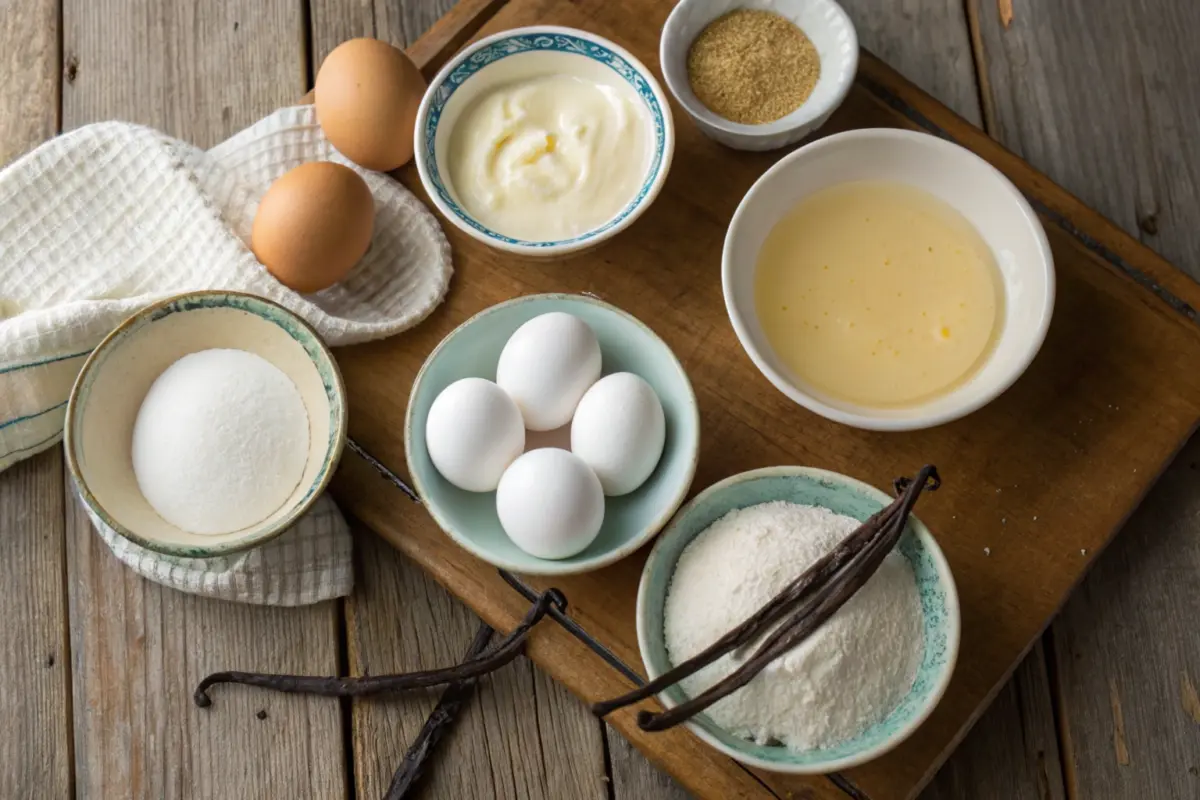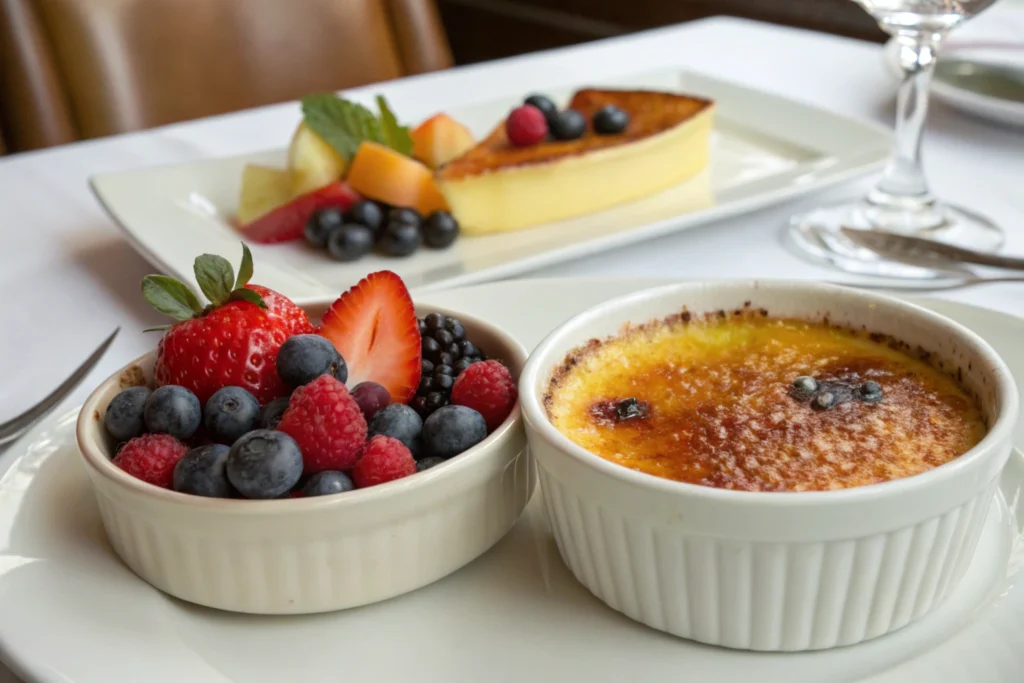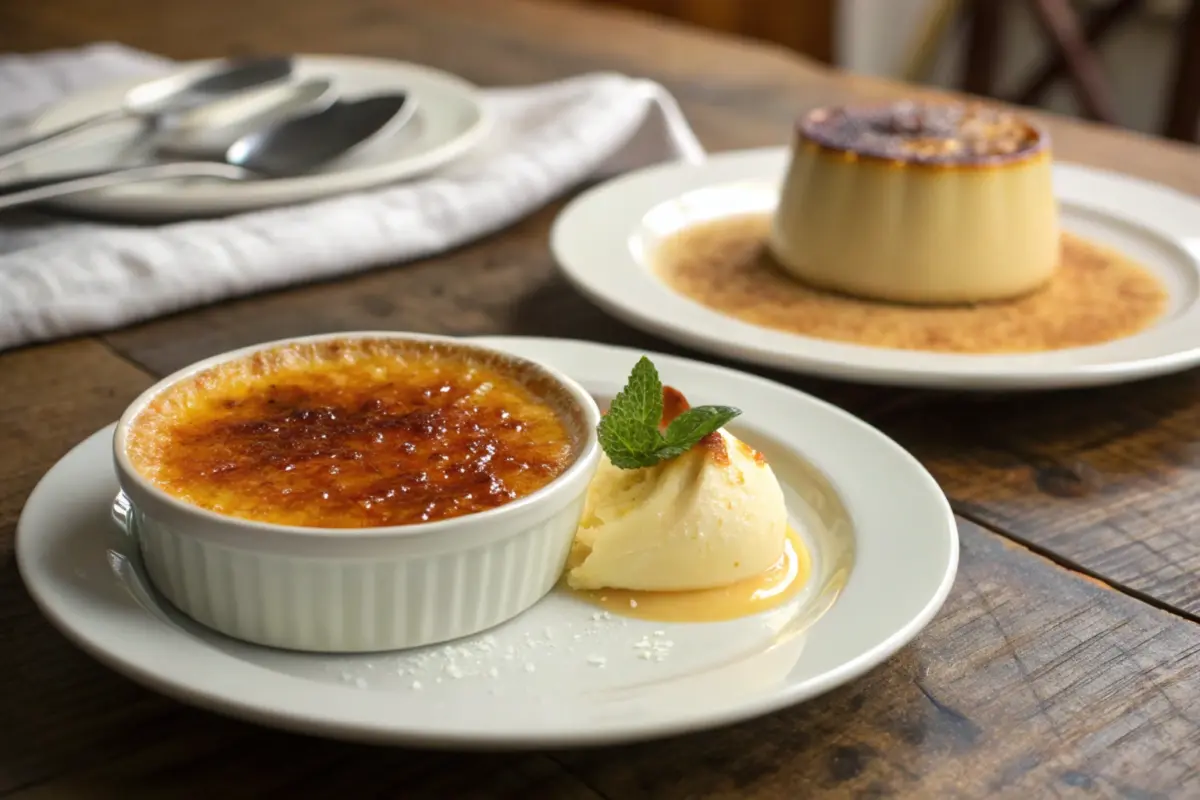Understanding the Basics of Crème Brûlée and Custard
What is Crème Brûlée?
Crème brûlée, often hailed as a luxurious dessert, is a custard-based treat topped with a caramelized sugar layer. This indulgent dessert combines creamy custard with a crunchy topping, offering a delightful contrast in textures. Typically served in individual ramekins, the dish is a favorite in fine dining and special occasions.
The name crème brûlée translates to “burnt cream” in French, referring to the caramelized sugar crust. The custard base is made from heavy cream, egg yolks, sugar, and vanilla, resulting in a rich and velvety dessert. The process of torching the sugar to create a crackable top layer adds to its allure, making it as visually appealing as it is delicious.
What sets crème brûlée apart is its balance of sweetness and creamy texture, making it a dessert that’s simple yet elegant.
What is Custard?
Custard, on the other hand, is a versatile dessert that serves as the foundation for many dishes. At its core, custard is a mixture of milk or cream, eggs, and sugar, thickened either by cooking or baking. Unlike crème brûlée, custard doesn’t include a caramelized sugar topping.
Custards can be served in various forms, from the firm texture of baked custard to the creamy smoothness of stirred custard. Often flavored with vanilla, they can also incorporate ingredients like chocolate, fruit, or spices for added variety. While custard is a dessert in its own right, it also serves as a base for dishes such as pies, trifles, and ice cream.
This simple yet adaptable dish appeals to a wide range of tastes, making it a classic in kitchens worldwide.
Ingredients and Their Unique Roles

Key Ingredients of Crème Brûlée
Crème brûlée’s signature taste and texture come from a handful of essential ingredients:
- Heavy cream: Provides the richness and smoothness.
- Egg yolks: Act as the thickening agent, giving the custard its creamy consistency.
- Sugar: Sweetens the custard and forms the caramelized topping.
- Vanilla: Adds a subtle, aromatic flavor.
The heavy cream ensures that crème brûlée is richer than traditional custard. The caramelized sugar topping, achieved through broiling or using a torch, creates a distinct contrast of textures.
Essential Ingredients of Custard
The ingredients for custard are simpler but equally impactful:
- Milk or cream: Forms the base of the dish.
- Whole eggs or egg yolks: Provide structure and thickness.
- Sugar: Sweetens the mixture.
- Flavoring: Vanilla is the most common, but others like nutmeg or lemon zest can be used.
Milk-based custards are lighter compared to crème brûlée. The absence of a sugar crust makes custard softer, with a focus on its creamy texture rather than contrasts.
Cooking Techniques: A Side-by-Side Comparison
Preparation Process for Crème Brûlée
The preparation of crème brûlée requires precision and attention to detail. Begin by whisking egg yolks and sugar until the mixture turns pale. Meanwhile, gently heat heavy cream with vanilla, ensuring it doesn’t boil. Gradually pour the warm cream into the yolk mixture, stirring constantly to prevent the eggs from curdling.
Pour the custard mixture into individual ramekins and bake them in a water bath to maintain consistent cooking temperature. After baking, allow the custard to cool completely. Before serving, sprinkle an even layer of sugar over the surface and use a kitchen torch to caramelize it. This step creates the iconic crisp, golden-brown crust.
The key to perfect crème brûlée lies in maintaining low, steady heat during baking and applying just the right amount of flame to achieve an evenly caramelized topping.
Making Custard: An Overview
Making custard involves a simpler yet equally delicate process. For stirred custard, whisk the eggs and sugar together in a bowl. Gradually add warmed milk or cream, stirring to combine. Cook this mixture over low heat, stirring continuously, until it thickens enough to coat the back of a spoon. Avoid overheating to prevent curdling.
For baked custard, combine the ingredients, pour the mixture into a dish or ramekins, and bake it in a water bath until it sets. Once done, let it cool before serving.
Smooth, lump-free custard depends on consistent stirring and moderate heat during cooking. Whether served warm or chilled, the results should be creamy and satisfying, showcasing its versatility in both flavor and texture.
Texture and Consistency: Spot the Difference
The Velvety Texture of Crème Brûlée
Crème brûlée is renowned for its creamy yet firm texture. The use of heavy cream gives the custard a velvety consistency, setting it apart from other desserts. The caramelized sugar topping provides a contrasting crunch, enhancing the overall experience.
When properly made, crème brûlée offers a custard that is smooth and rich, holding its shape while melting in your mouth. The interplay of the silky base and the crisp top is what makes this dessert unique.
The Silky Smoothness of Custard
Custard, on the other hand, is characterized by its smooth and soft consistency. Whether stirred or baked, custard should be creamy without being overly dense. The lighter texture comes from the use of milk or a milk-cream blend.
A well-made custard is smooth, with no lumps or curdling, making it a comforting dessert. Its softness and versatility make it a favorite for pairing with fruits, sauces, or pastries.
Flavor Profiles: How Do They Compare?
The Richness of Crème Brûlée
Crème brûlée is indulgent, with its flavor dominated by the richness of heavy cream and the subtle sweetness of vanilla. The caramelized sugar topping adds a slightly bitter, smoky note, balancing the overall sweetness.
This dessert is perfect for those who enjoy a deeper, more luxurious flavor, with every bite offering a combination of creamy custard and crunchy sugar.
The Subtle Sweetness of Custard
Custard’s flavor is milder, making it an excellent base for various additions. Its sweetness is more subdued, allowing flavors like vanilla or spices to shine through.
Custard’s lighter profile makes it more versatile, whether served plain, topped with fruit, or incorporated into other desserts.
Serving Styles and Presentation

How Crème Brûlée is Served
Crème brûlée is typically served in individual ramekins, emphasizing its elegant nature. The caramelized sugar crust is often the highlight, cracked just before eating to reveal the creamy custard underneath.
Garnishes like fresh berries, mint leaves, or a dusting of powdered sugar can enhance its presentation without overpowering its flavors.
Traditional Ways to Present Custard
Custard is served in a variety of ways, depending on the dish. It can be spooned into bowls, poured into pie crusts, or layered with fruit and cake.
Its simplicity makes it suitable for both casual and formal settings, with garnishes like whipped cream or fruit adding a touch of flair.
Historical Origins and Cultural Significance
Tracing the History of Crème Brûlée
Crème brûlée has its roots in European cuisine, with its origins debated between France, Spain, and England. Each country has its version, but the French iteration remains the most famous.
The dessert gained prominence in the 17th century and has since become a symbol of fine dining, celebrated for its intricate preparation and luxurious taste.
The Origins and Evolution of Custard
Custard dates back to ancient times, with early versions found in Roman cuisine. It became a staple in medieval European kitchens, often used as a filling for pies and tarts.
Custard’s adaptability has allowed it to evolve, influencing countless recipes worldwide, from simple puddings to elaborate desserts.
Popularity Around the World
Crème Brûlée in Global Cuisines
Crème brûlée has a reputation as a refined dessert, often associated with French cuisine. However, its appeal transcends borders. Countries like Spain and Portugal serve similar desserts, such as crema catalana and leite creme, which are often confused with crème brûlée due to their caramelized toppings.
In modern culinary scenes, crème brûlée has been adapted to include diverse flavors, including matcha in Japan, coconut in tropical regions, and even savory twists in gourmet dining. Its individual serving style and dramatic caramelization process make it a showstopper in restaurants worldwide.
Despite its sophisticated image, crème brûlée has found a place in casual dining menus, proving that its appeal is universal.
Custard’s Universal Appeal
Custard, unlike crème brûlée, is a cornerstone of desserts across the globe. In the UK, custard accompanies puddings, while in the US, it’s a key ingredient in pies like Boston cream. In Asia, egg custards are popular in dim sum or as fillings in pastries.
Custard’s adaptability is its strength. It can be flavored, layered, or used as a filling, making it a versatile component in countless recipes. From flan in Latin America to natillas in Spain, custard reflects regional culinary traditions while retaining its classic simplicity.
Its universal appeal lies in its comforting texture and mild flavor, making it a staple in both home kitchens and professional bakeries.
Nutritional Comparison: Which One is Healthier?
Caloric and Nutritional Content of Crème Brûlée
Crème brûlée, with its rich ingredients, is a calorie-dense dessert. A single serving can range from 200 to 400 calories, depending on the recipe. Heavy cream and egg yolks contribute to its high fat content, while the caramelized sugar topping adds a layer of simple carbohydrates.
While crème brûlée is indulgent, it does offer small amounts of protein and calcium from the eggs and cream. However, its high saturated fat and sugar levels make it a dessert best enjoyed occasionally.
Health Benefits and Concerns of Custard
Custard’s nutritional profile varies depending on its preparation. A milk-based custard is generally lower in calories than crème brûlée, with fewer fats and sugars. For example, a cup of plain custard might contain 150-250 calories.
Custard provides protein, calcium, and vitamins from eggs and milk, making it a slightly healthier option for regular consumption. However, store-bought or overly sweetened custards may have added sugars and preservatives, reducing their nutritional benefits.
When prepared with lighter ingredients, custard can be a wholesome treat, suitable for more frequent enjoyment.
When to Choose Crème Brûlée Over Custard and Vice Versa
Crème Brûlée for Special Occasions
Crème brûlée shines as a dessert for celebrations and elegant dinners. Its presentation, with the dramatic cracking of the caramelized top, adds a touch of theater to any meal. Its rich, luxurious flavor pairs well with fine dining, making it ideal for holidays, anniversaries, or formal gatherings.
If you’re looking to impress guests with a sophisticated dessert, crème brûlée is the perfect choice.
Custard for Everyday Desserts
Custard, in contrast, is more versatile and suitable for everyday indulgence. Whether served warm with fruit or cold in a trifle, it offers comfort and simplicity. Custard’s ability to complement other ingredients makes it an excellent choice for family meals or casual get-togethers.
Its lighter preparation means you can enjoy custard regularly without feeling overindulgent.
Frequently Asked Questions About Crème Brûlée and Custard
What Makes Crème Brûlée Unique?
Crème brûlée stands out because of its caramelized sugar topping, which creates a delightful contrast between the crispy surface and the creamy custard underneath. This combination of textures, along with its rich flavor, makes it a show-stopping dessert.
Can Crème Brûlée Be Made Without a Torch?
Yes, you can caramelize the sugar topping without a torch. Use your oven’s broiler function to heat the sugar until it melts and forms a crust. Keep a close eye on the process to avoid burning.
Is Custard the Same as Pudding?
No, custard and pudding differ in their thickening methods. Custard relies on eggs for its creamy texture, while pudding often uses cornstarch or gelatin as a thickener. As a result, custard has a richer and silkier texture, while pudding is usually smoother and lighter.
How Do I Prevent Custard from Curdling?
To prevent curdling, cook custard over low heat and stir it continuously. If baking, use a water bath to ensure gentle, even heat. Rapid temperature changes or overheating are the primary causes of curdling, so take care to cook it slowly and consistently.
Can You Turn Custard into Crème Brûlée?
Yes, you can transform custard into crème brûlée by adding a caramelized sugar topping. Ensure the custard is rich and firm enough, ideally made with cream and egg yolks, to mimic the texture of traditional crème brûlée.
What Is the Best Way to Serve Custard?
Custard is incredibly versatile and can be served warm, cold, or as part of other desserts. Enjoy it on its own, paired with fresh fruit, or layered into trifles and pies. Its simplicity allows it to complement a variety of flavors and dishes.
Conclusion: Embracing the Sweet Differences
Crème brûlée and custard may share similarities, but their differences make each dessert unique. Crème brûlée offers richness and elegance, perfect for special occasions, while custard’s versatility and comfort make it a staple for everyday desserts.
Understanding their textures, flavors, and preparation methods helps you appreciate their individual charms. Whether you prefer the crack of caramelized sugar or the creamy simplicity of custard, both desserts have earned their place in culinary history as timeless classics.

